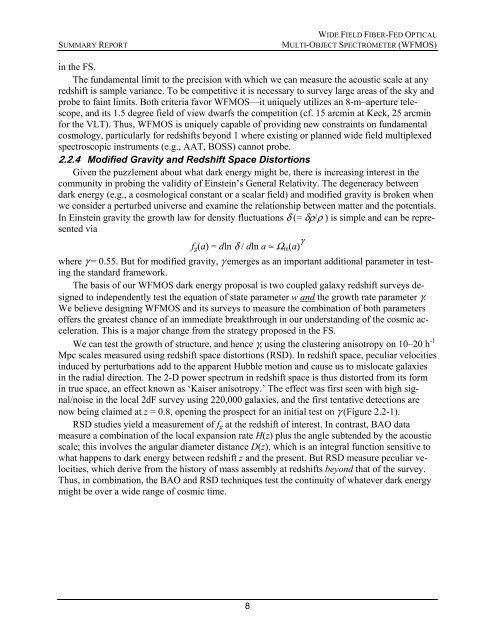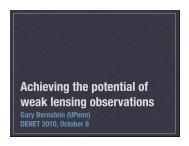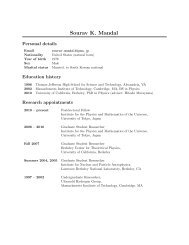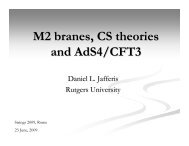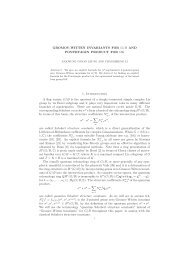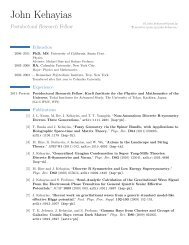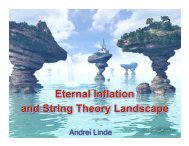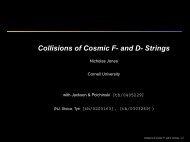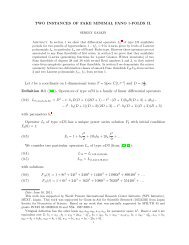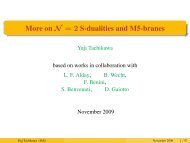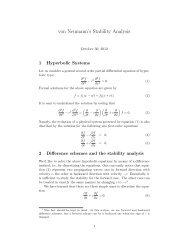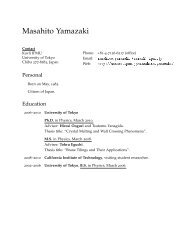STUDY SUMMARY - IPMU
STUDY SUMMARY - IPMU
STUDY SUMMARY - IPMU
You also want an ePaper? Increase the reach of your titles
YUMPU automatically turns print PDFs into web optimized ePapers that Google loves.
<strong>SUMMARY</strong> REPORT<br />
WIDE FIELD FIBER-FED OPTICAL<br />
MULTI-OBJECT SPECTROMETER (WFMOS)<br />
in the FS.<br />
The fundamental limit to the precision with which we can measure the acoustic scale at any<br />
redshift is sample variance. To be competitive it is necessary to survey large areas of the sky and<br />
probe to faint limits. Both criteria favor WFMOS—it uniquely utilizes an 8-m–aperture telescope,<br />
and its 1.5 degree field of view dwarfs the competition (cf. 15 arcmin at Keck, 25 arcmin<br />
for the VLT). Thus, WFMOS is uniquely capable of providing new constraints on fundamental<br />
cosmology, particularly for redshifts beyond 1 where existing or planned wide field multiplexed<br />
spectroscopic instruments (e.g., AAT, BOSS) cannot probe.<br />
2.2.4 Modified Gravity and Redshift Space Distortions<br />
Given the puzzlement about what dark energy might be, there is increasing interest in the<br />
community in probing the validity of Einstein’s General Relativity. The degeneracy between<br />
dark energy (e.g., a cosmological constant or a scalar field) and modified gravity is broken when<br />
we consider a perturbed universe and examine the relationship between matter and the potentials.<br />
In Einstein gravity the growth law for density fluctuations δ (= δρ/ρ ) is simple and can be represented<br />
via<br />
f g (a) = dln δ / dln a ≈ Ω m (a) γ<br />
where γ = 0.55. But for modified gravity, γ emerges as an important additional parameter in testing<br />
the standard framework.<br />
The basis of our WFMOS dark energy proposal is two coupled galaxy redshift surveys designed<br />
to independently test the equation of state parameter w and the growth rate parameter γ.<br />
We believe designing WFMOS and its surveys to measure the combination of both parameters<br />
offers the greatest chance of an immediate breakthrough in our understanding of the cosmic acceleration.<br />
This is a major change from the strategy proposed in the FS.<br />
We can test the growth of structure, and hence γ, using the clustering anisotropy on 10–20 h -1<br />
Mpc scales measured using redshift space distortions (RSD). In redshift space, peculiar velocities<br />
induced by perturbations add to the apparent Hubble motion and cause us to mislocate galaxies<br />
in the radial direction. The 2-D power spectrum in redshift space is thus distorted from its form<br />
in true space, an effect known as ‘Kaiser anisotropy.’ The effect was first seen with high signal/noise<br />
in the local 2dF survey using 220,000 galaxies, and the first tentative detections are<br />
now being claimed at z = 0.8, opening the prospect for an initial test on γ (Figure 2.2-1).<br />
RSD studies yield a measurement of f g at the redshift of interest. In contrast, BAO data<br />
measure a combination of the local expansion rate H(z) plus the angle subtended by the acoustic<br />
scale; this involves the angular diameter distance D(z), which is an integral function sensitive to<br />
what happens to dark energy between redshift z and the present. But RSD measure peculiar velocities,<br />
which derive from the history of mass assembly at redshifts beyond that of the survey.<br />
Thus, in combination, the BAO and RSD techniques test the continuity of whatever dark energy<br />
might be over a wide range of cosmic time.<br />
8


